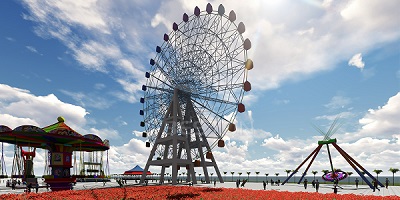


Controlled amusement rides reduce acrophobia symptoms through gradual exposure therapy.
Acrophobia, the intense fear of heights, remains one of the most prevalent specific phobias worldwide. Characterized by overwhelming anxiety during elevation exposure, it can severely limit occupational and recreational functioning. Modern therapeutic methodologies have moved beyond static exposure techniques to adopt more immersive and structured protocols—among them, acrophobia desensitization training utilizing controlled amusement rides.
The integration of dynamic environments into exposure therapy is not novel. However, using real-world vertical motion systems such as amusement rides provides a multifaceted sensory stimulus. Controlled stimuli—like slow acceleration, secure restraint systems, and predictable altitude changes—allow for repeatable, scalable exposure in a relatively safe setting. These variables form the backbone of graduated desensitization.
The ferris wheel presents a foundational tool in height exposure therapy. Its slow, circular motion and transparent elevation give users a stable visual reference while minimizing kinematic stress. The compartmentalized seating arrangements reinforce safety perceptions, enabling the participant to recalibrate irrational threat assessments.
Therapists typically employ the ferris wheel at early stages of exposure therapy. The goal is to foster tolerance for elevation through passive vertical engagement. Sessions are often structured with stepwise modifications in ride duration, gondola height stops, and viewing instructions (e.g., look outward versus inward). Physiological responses such as heart rate and galvanic skin response are monitored to track habituation.
The swing ride, with its radial movement and centrifugal force, introduces a complex vestibular stimulus. While the elevation is modest compared to high-drop attractions, the dynamic sway mimics instability—an element that often triggers anticipatory anxiety in acrophobic individuals.
In a training context, the swing ride is used after a patient demonstrates tolerability with static or slow-moving elevation platforms. The semi-suspended seating, coupled with oscillating motion, forces the participant to confront a perceived lack of control. Cognitive reframing techniques are deployed in tandem, encouraging reinterpretation of somatic sensations (e.g., fluttering stomach, tension in limbs) as non-lethal bodily responses.
Desensitization efficacy is measured not just by subjective discomfort but through objective indicators. Heart rate variability (HRV), respiratory rate, and cortisol levels can serve as reliable markers. Moreover, psychometric tools like the Acrophobia Questionnaire (AQ) help quantify cognitive shifts pre- and post-exposure.
Repeated exposures—preferably with incremental intensities—lead to neural adaptation. The amygdala’s hyperactive threat response diminishes, while the prefrontal cortex asserts greater executive control over emotional regulation. This neural recalibration underpins long-term habituation and generalization to real-world height scenarios.
All ride-based desensitization protocols are contingent on strict safety parameters. Amusement park operators collaborating with clinical professionals must ensure consistent mechanical inspections, rider briefing systems, and emergency cessation capabilities.
Additionally, participants undergo pre-screening for medical contraindications. Those with vestibular disorders, cardiovascular sensitivities, or severe panic response profiles may require alternative modalities before progressing to ride-based exposure.
Ride exposure, while potent, is not a standalone solution. It is typically embedded within a cognitive behavioral therapy (CBT) framework. Pre-exposure sessions focus on psychoeducation and expectation management, while post-exposure debriefs consolidate learning and assess maladaptive thought patterns.
For example, after experiencing a swing ride, participants might journal their physiological reactions and rate their distress levels. These reflections help dismantle cognitive distortions such as catastrophic thinking (“I’m going to fall” or “I’ll lose control”).
Amusement rides such as the ferris wheel and swing ride serve as viable, controlled tools for acrophobia desensitization. Their structured movement patterns, scalable intensity, and immersive sensory inputs align with modern behavioral therapy principles. When deployed within a supervised framework, these rides can significantly reduce height-related anxieties and restore autonomy to individuals debilitated by acrophobia.
